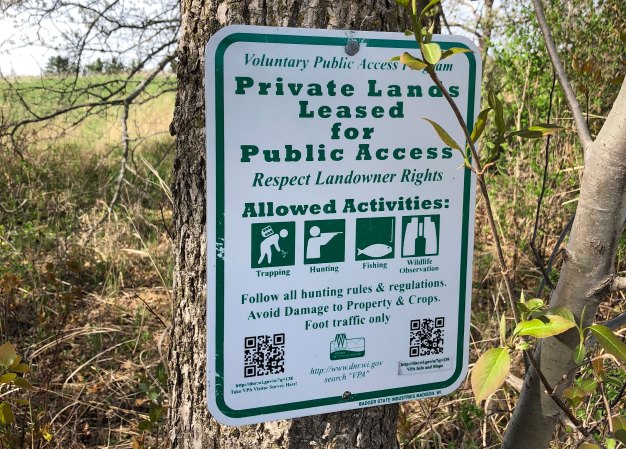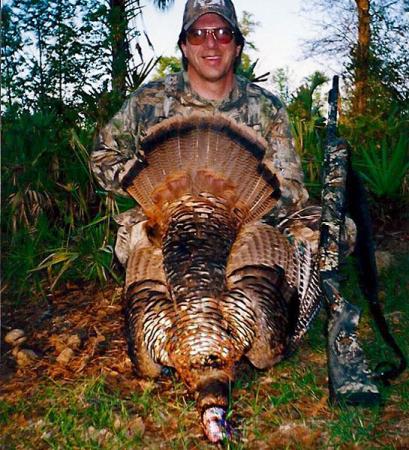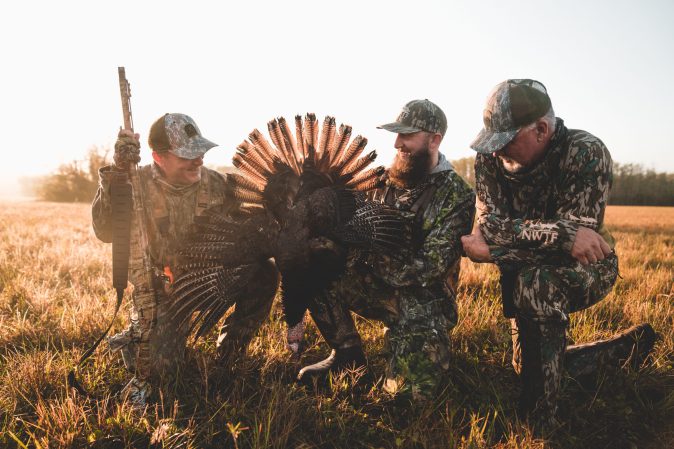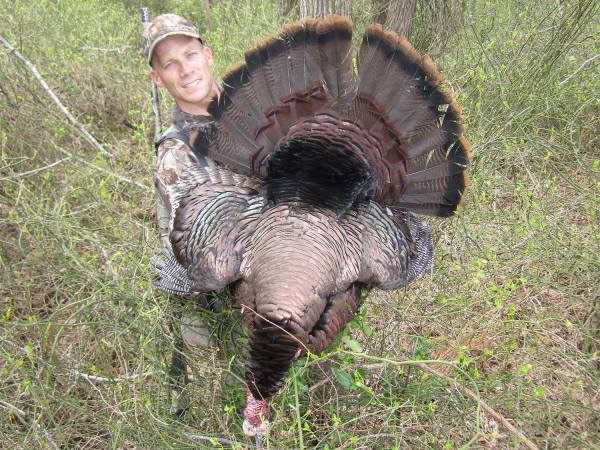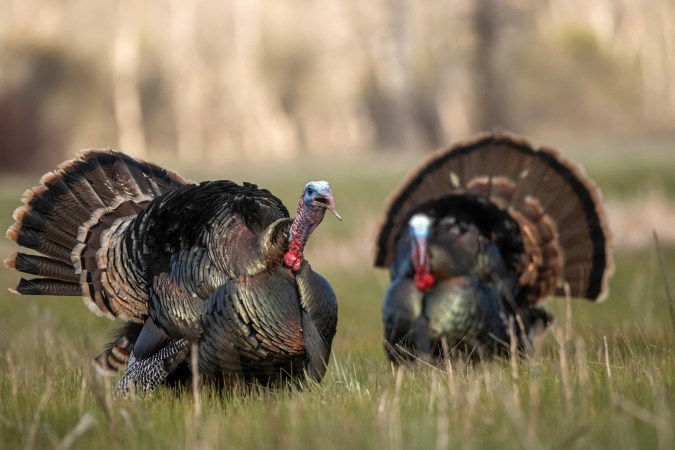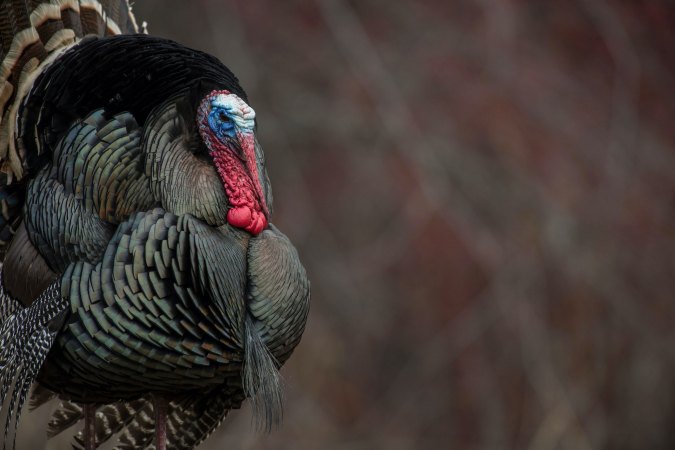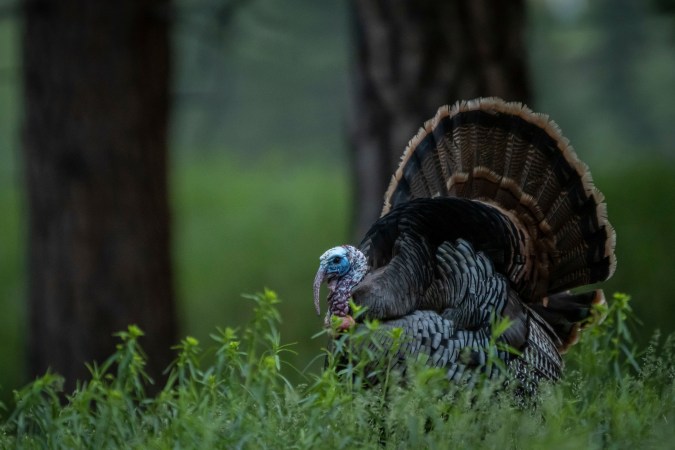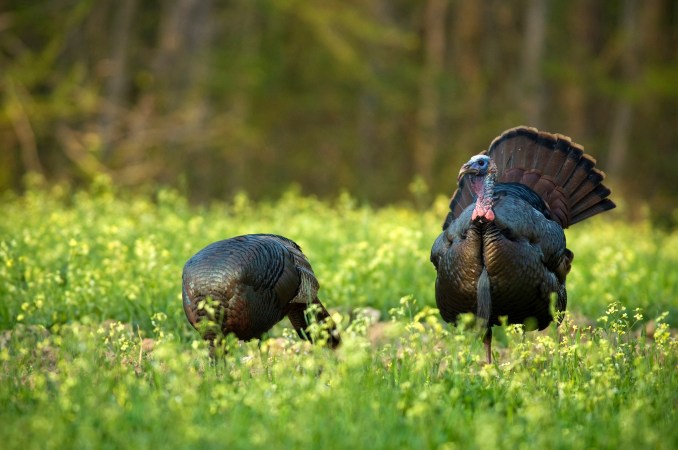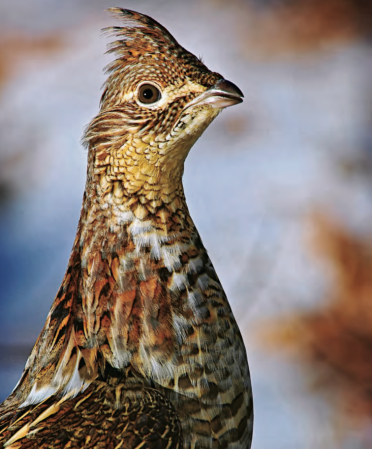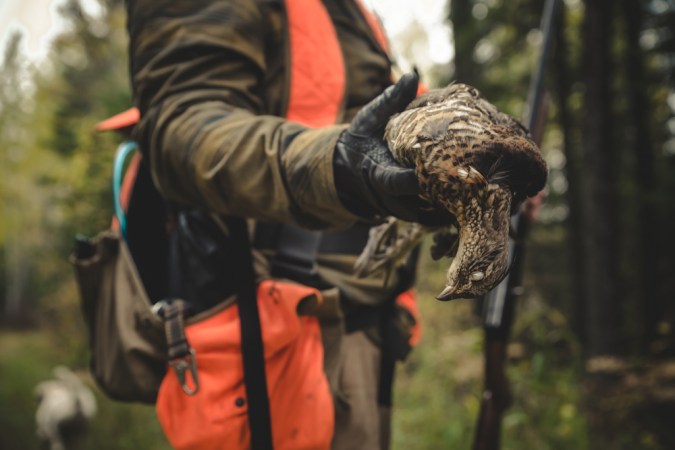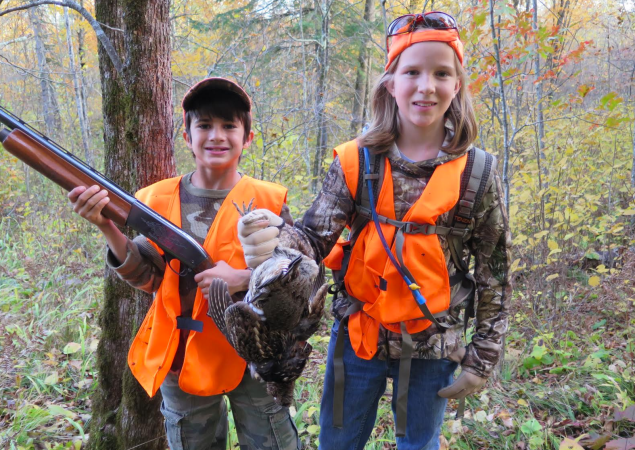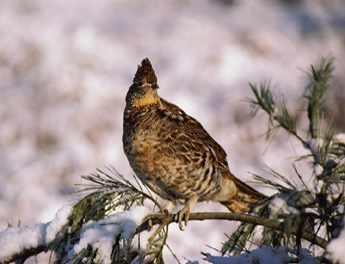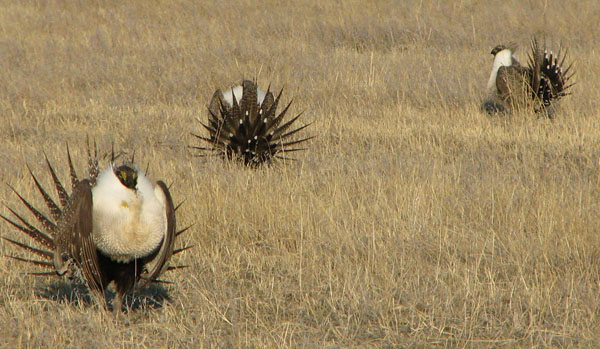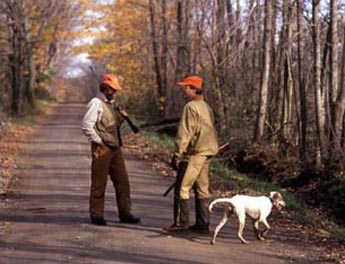There are plenty of ruffed grouse to be found this fall, providing you put yourself in the right places to hunt them. The right places might not be your tried-and-true grouse hot spots–the odds are high that they aren’t as good as they used to be. As far as ruffs are concerned, the habitat in your secret grouse getaway is getting older, but probably not better. Grouse like a messy landscape, with a vibrant mix of plants and trees and a range of menu items.
This year, hunt for good habitat before you hunt for grouse. Find relatively new patches of brush and thorns tangled with wild grapevines and sticker bushes where even a dog has difficulty getting through. If the walking is easy, you’re probably in the wrong place to hunt grouse.
In the northern states, look also for young poplar trees and, in the southern states where grouse are hunted, locate dense patches of rhododendron and mountain laurel close to fruitful oak and beech trees.
On a nationwide basis, the ruffed grouse population appears to be gradually declining. But members and volunteers of the Ruffed Grouse Society (www.ruffedgrousesociety.org) are working with various state agencies to improve grouse habitat. Long-term, the picture looks brighter, as a consortium of wildlife managers, sportsmen and other conservationists are beginning to focus on some of the problems that beset ruffed grouse and develop restoration plans.
Northwest States
In many areas of the Northwest, three species of “forest” grouse (blue, spruce and ruffed) can be hunted, although each prefers somewhat different habitats. The more commonly found ruffed grouse prefers lower, moister elevations. Ruffed grouse populations have recently declined in Washington, but not critically so, says biologist Rick Cope. A series of cold, wet springs has impacted grouse, and grouse hunter participation is down from recent years. Forest composition is maturing past the young, “scruffy” cover in which grouse thrive.
In Idaho, ruffed grouse populations are higher in the northern regions of the panhandle, where nearly 95 percent of the birds are in the gray color phase. Idaho doesn’t conduct spring drumming counts, but as biologist Jim Hayden points out, drumming doesn’t predict nesting success, the real indicator of hunter success. Because Idaho grouse are not seasonally dependent on any one source of food and have a variety of soft mast (berries) and mountain ash buds, the population is relatively stable year to year.
Wyoming’s ruffed grouse harvest decreased last year after reaching a high the year before. Biologist Grant Frost anticipates that current habitat conditions will produce an above-average hunting season this year. Alaska is home to a thriving population of grouse. According to Bill Taylor, a wildlife veterinarian, the best time to hunt the birds is mid-September in the western and central interior, where grouse are increasing in the third year of a 10-year cycle.
Great Lakes States
There’s an ongoing rivalry between East and West regarding the best place to hunt ruffed grouse. Minnesota, Wisconsin and Michigan in the West usually can boast the highest flushes-per-hour rate (FPH), but because of the relatively unvaried habitat of poplars and pines, grouse populations tend to cycle from low to high and back again over a period of roughly 10 years. Last year, hunters in those three states produced an average 1.39 FPH. In Michigan, the average was a high 1.46 FPH–the highest in the nation–though scarcely higher than Minnesota’s estimated 1.4. On the eastern side of the Great Lakes in New York, Pennsylvania and Ohio, the overall flush rate last year averaged a lower 1.08 FPH. However, Pennsylvania rated 1.35 FPH, which is none too shabby. Based on the hunter survey of birds flushed, Pennsylvania in the Northeast and Michigan/Minnesota in the Midwest are the hot spots for the 2003-04 season.
Grouse hunters in Michigan will have expanded hunting opportunities in the Upper Peninsula (UP) this year. The grouse season there has been extended to run from December 1 to January 1–that on top of the regular season of September 15 through November 14. Last year, grouse flush rates were highest in the UP (Zone 1), where the bag limit is five birds per day, as it also is in the northern Lower Peninsula (Zone 2). Nearly a third of Michigan’s total acreage is accessible for hunting and there are more than 70 state game areas and other wildlife management areas. Michigan grouse hunters have it good.
Only five years ago, members of the Loyal Order of Grouse Hunters in Minnesota flushed an astoundingly high average of 3.6 grouse per hour. That’s an average of one bird flushed every 17 minutes! Although the average FPH was down to less than half that last year, there’s still good hunting to be had even in the middle of a “down cycle,” according to Rick Horton, biologist with the Ruffed Grouse Society. Horton advises hunters to concentrate their efforts in the northwest zone near Bemidji and the central Brainerd area. He also recommends focusing on county-owned lands that are managed for hunting–the farther away from ATV trails, the better.
The states that border the eastern Great Lakes, including Ohio and New York, have more stable grouse populations from year to year. Wildlife biologists attribute this to the more varied habitat of wild berries, nuts and fruits in addition to patchwork patterns of hardwoods and abandoned farmlands reverting to pines and poplars. The caveat here is spring weather: Buckets of rain fell in eastern areas of Pennsylvania and New York in May and June, which probably hurt chick survival.
The ruffed grouse is the official state bird of Pennsylvania, and hunters there spend more time hunting grouse than fall turkeys, pheasants, geese, ducks or doves. According to Wildlife Manager Bill Palmer, the slight decline in grouse from year to year is a result of a gradual loss of ideal habitat as forests mature. If you can locate the right scruffy habitat, however, the hunting is still as good as it was 40 years ago. Palmer recommends the western regions of the state, particularly the old strip-mined areas, and the north-central regions.
In the Great Lakes region as a whole, honorable mention must be made to Wisconsin, which annually is in direct competition with Minnesota and Michigan as the best producer.
Mid-Atlantic States
Although not traditionally associated with grouse hunting, the Mid-Atlantic states as far south as northern Georgia are home to ruffed grouse. In fact, the most important research in over half a century on what affects annual grouse populations is being done now by the Appalachian Grouse Cooperative Research Project (AGCRP). This project is coordinated by Gary Norman in Virginia. His prediction for Virginia’s 2003 autumn season is not optimistic, based on the comparatively low spring drumming count, the continued wet weather during nesting season and last year’s poor acorn crop. West Virginia had much the same poor spring weather as Virginia, but also suffered some severe ice storms, which can be particularly hard on grouse. The northern woodlands of New Jersey have good potential for grouse, but this season’s hunting will be slim pickings because of unusually low temperatures and deep snow last winter.
Bob Long of the AGCRP in Maryland has found that beechnut and acorn production throughout Appalachia is a predictor of grouse nesting success during the spring. This nutritious hard mast diet produces healthier hens and gives springtime grouse chicks a head start for summer survival. Unfortunately, much of the oak and beech fruiting throughout Appalachia this past fall has been below normal. Hunters are advised to seek areas where mountain laurels and ferns grow. These are less desirable grouse food, but better than nothing.
A good spring hatch is only part of the story. Although brood mortality can be very high in the late spring, quality habitat and a warm, dry summer help the remaining young grouse survive the summer months and early autumn. Wildlife researcher Ben Jones has studied hen grouse in Tennessee and North Carolina by radio-telemetry. As of early July of this year, his research indicated a surprisingly high survival rate, considering the wet spring weather, so the coming season could be a good one. Similar conditions apply to northern Georgia, where in the right habitat (hard to find on public land), hunters will find isolated pockets of grouse this year.
The habitat along the slopes of the Appalachian mountains differs from elsewhere in the United States, and grouse are most likely to be found near areas where patches of dense rhododendron and mountain laurel butt up against the saplings of 10-year-old hardwood clear-cuts. This was determined by AGCRP biologist Todd Fearer, who reached that conclusion by overlaying satellite data from radio-monitored grouse on area maps that combined contour and vegetation types. The grouse flush rate averages an unremarkable 0.96 FPH in the Appalachian states, but this is typical of most states except those of the western Great Lakes and Pennsylvania.
New England
In Maine, Andy Weik of the Upland Game Program reports that grouse in central and northern Maine seemed to be more abundant than usual last spring. In Vermont, the general consensus is that the grouse population is stable and the fall season should be average–which is to say pretty good. Vermont received above-average snowfall last winter in the southern regions, but grouse can thrive under such conditions because deep snow helps protect them from predators. The Vermont legislature recently awarded a $50,000 grant to the Ruffed Grouse Society to accelerate the process of wildlife management.
Spring drumming counts in Massachusetts over the past eight years indicate that the grouse population in the western region has been relatively stable from year to year. The past couple of years, however, saw the poulation decline slightly.
The drumming count was down this spring in New Hampshire. However, Julie Robinson, who heads the small-game project there, believes that a wet spring delayed the breeding season so that a true picture of the grouse population couldn’t be obtained during the normal drumming survey period.
Ruffed Grouse Population Densities Data derived from Audubon 2001 Christmas Bird Count as compiled by the U.S. Geologic Survey. Numbers indicate average total of ruffed grouse seen or heard during 2 1/2-hour time period by surveyors observing from rural roads.
Hunt Without a Heavy Load
Pella’s Bird’n Lite Upland Hunting Vest features a patented design that distributes the weight a wing-shooter lugs around during a long day in the grouse woods. As a result, stress on the shoulders is reduced substantially and the hunter is less fatigued. An adjustable waist belt, sternum straps and padded shoulder straps are incorporated into the vest to help carry the load.
A lined game pocket, expandable shell pockets and a built-in backpack provide storage space. The Bird’n Lite vest is constructed of tan duck cloth (60 percent cotton, 40 percent polyester) with hunter-orange shoulder and yoke patches. (About $100; Pella Products, 641-628-3092; www.pellaproducts.com.)

